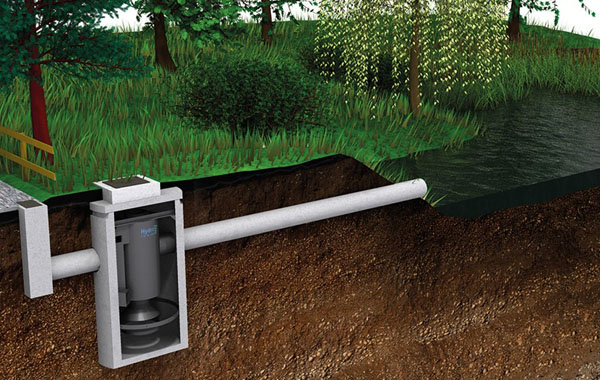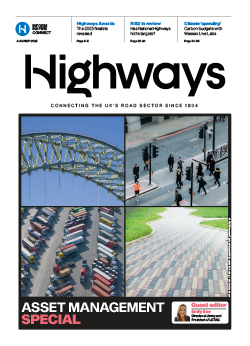As flooding risks rise, the highways sector is facing increasing calls to tackle the 'dangerous cocktail' of pollutants caused by road run-off into watercourses, with MPs and campaigners raising the alarm.
In its recently-published Water Quality in Rivers report, the House of Commons Environmental Audit Committee (EAC) cited road run-off as a major source of toxic pollution in our waterways, with no river in England given a ‘clean bill of health’.
MPs on the cross-party committee specifically warned National Highways that it 'must accelerate its efforts to eliminate toxic chemical and plastic pollution from the most polluting outfalls on the Strategic Roads Network (SRN) by 2030 in line with the Government’s commitments to halt species decline'.
The urgent call was followed by a veiled threat that the committee expects 'to see far more assertive regulation and enforcement from Ofwat and the Environment Agency to restore our rivers to their natural glory'.
MPs reported that pollution from road runoff can contain 'high levels of pollutants including polycyclic aromatic hydrocarbons which are persistent and carcinogenic' as well microplastics from worn away from brakes and tyres.
Runoff from roads produces 'a dangerous cocktail', according to Jo Bradley of Stormwater Shepherds, an organisation campaigning to stop urban and plastic pollution at source.
Ms Bradley described the three main components of highway run-of: 'One is the suspended solids. The amount of suspended solids in road runoff is immense, comparable to raw sewage, and those particles coat the base of the watercourse, the bed of the watercourse, and cause all sorts of problems for spawning grounds for fish but also create a source of pollution that is there all the time, insidiously releasing this pollution into the water column. The suspended solids are the biggest problem [..]. Within that, you have the polyaromatic hydrocarbons, which I have already mentioned because they are carcinogenic, and then you have dissolved metals, which are toxic to fish. You have this cocktail of pollutants.
'These organic compounds are identified as compounds of serious concern under REACH [chemical legislation]. They are carcinogenic, mutagenic, bioaccumulative and phytotoxic, which means that they sit within organisms and become more toxic as time goes by. They kill microscopic organisms in the sediment of the watercourse and therefore affect the entire ecosystem within the watercourse.'
The report noted that many of the drains and outfalls on the strategic road network have 'little or no measures to mitigate the risk of road run-off carrying pollutants into watercourses', adding that 'despite increasing concern about pollution from run-off, a permitting system has not yet been introduced'.
In fact, only 3,991 out of a total of 26,401 outfalls and soakaways across the SRN are thought to have measures in place to mitigate the risk of pollution to watercourses.

Nick Harris, chief executive of National Highways, conceded that out of a total of 18,000 outfalls and 8,000 soakaways on the SRN 1,326 were considered high risk.
In fairness, the national operator does appear to be acting on the issue but is not fully meeting its targets.
National Highways has a target to improve 17.5 linear kilometres of watercourse every year. The organisation’s annual report for 2020–21 states that it delivered 25 water quality initiatives, including mitigating 23 outfalls, improving 17km of waterbody.
On top of this, the environment department DEFRA noted a report by the Air Quality Expert Group last year indicating that non-exhaust emissions (NEEs) make up 60% of PM2.5 emissions and 73% of PM10 emissions across road transport.
Every time a vehicle uses its brakes, the brake rotor and brake pads abrade sending tiny particles of iron into the air that ultimately settle on the road surface. DEFRA’s report also indicates that iron particles from brake dust make up some 20% of traffic pollution.
Pollutant particles collect on the surfaces of roads during dry weather and are washed off during rainfall events, which are becoming increasingly common, into the drainage system.
One of the recommendations in the EAC report is that the Environment Agency require discharge permits for all outfalls on roads with an annual average daily traffic above 15,000 vehicles, establishing strict conditions for their management, so as to minimise pollution from run-off.
Another call from the MPs was for tyre manufacturers to contribute to the swifter implementation of mitigation measures through the proposed Extended Producer Responsibility scheme.
Drainage systems can also be used to collect the polluted surface water, providing an opportunity to remove pollutants before they reach a watercourse. These systems can be in the form of sustainable drainage systems (SuDS), both natural (such as swales) and manufactured.
One example of a manufactured system is advanced hydrodynamic vortex separators.
Hydro International, which produces the Downstream Defender, told Highways these can 'remove and retain fine and coarse particles, hydrocarbons and floatable debris from road surface water runoff'.
A spokesperson said: 'The Downstream Defender is a passive, gravity-fed device that requires no power and has no moving parts. Its small footprint and modular ‘plug-and-play’ design ensure that less time is spent at the roadside for installation and maintenance, reducing health and safety risks and providing cost savings.
First installed on the SRN on the M25 in 2007, this hydrodynamic vortex separator has since been referenced in the Design Manual for Roads and Bridges (DMRB) and installed on many more parts of the SRN.
It is also compliant with The British Water Code of Practice, Assessment of Manufactured Treatment Devices Designed to Treat Surface Water Runoff, and is also certified by the WRc.
A filtration device, such as the Up-Flo Filter, is another option.
Although not quite so commonplace on the road network, this can help treat metals such as iron, copper, titanium and magnesium, which are emitted by brake wear, or zinc emitted from tyre wear.
These devices can operate alone or combined as a management train and can be utilised where natural solutions are not an option, although they can also be used as part of SuDS, water sensitive urban design (WSUD), or LID or LEED systems.
A biofiltration device can also deliver high-performance pollutant removal in a small footprint, 'which is ideal for new and retrofit schemes in space-constrained sites,' Hydro International said.
Booking is now open for Cold Comfort Scotland 2022 on 7 April and Cold Comfort in Harrogate England.





